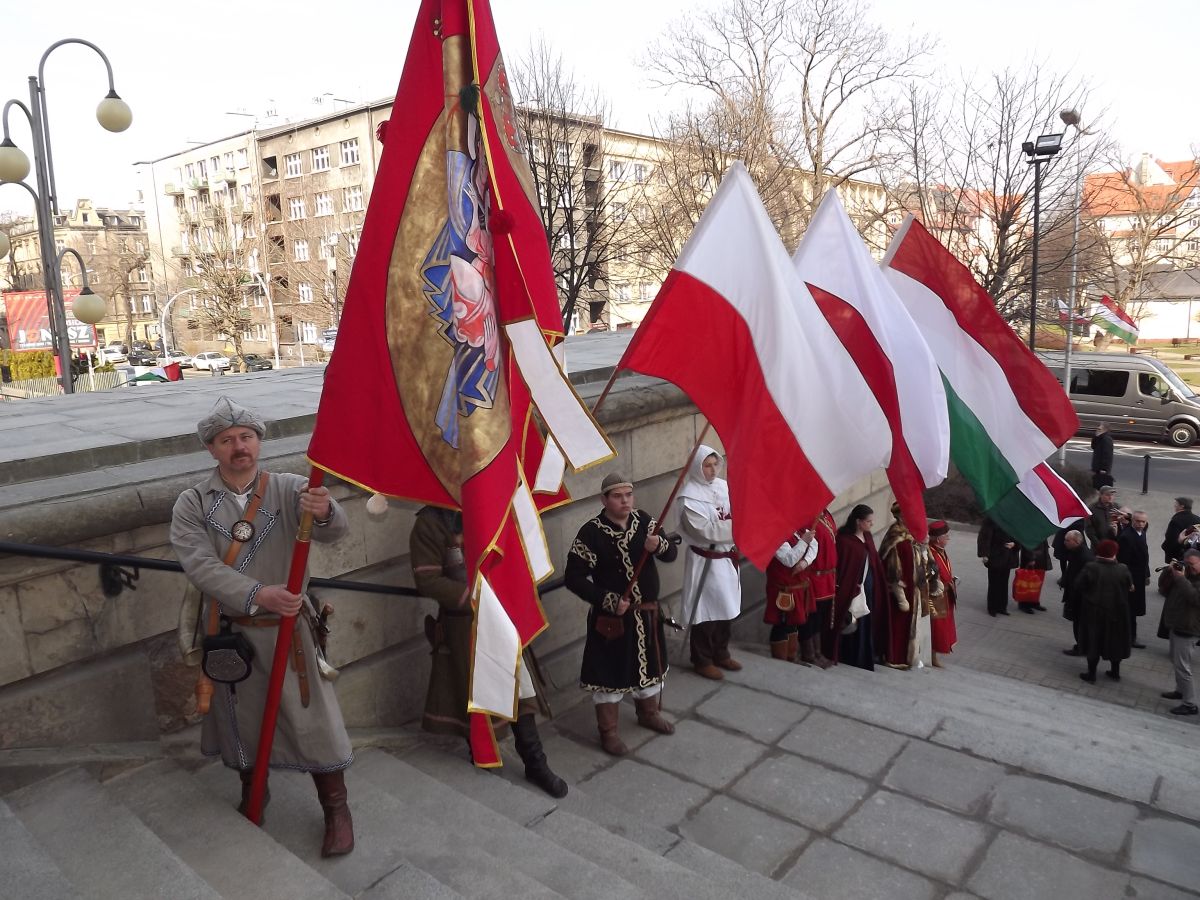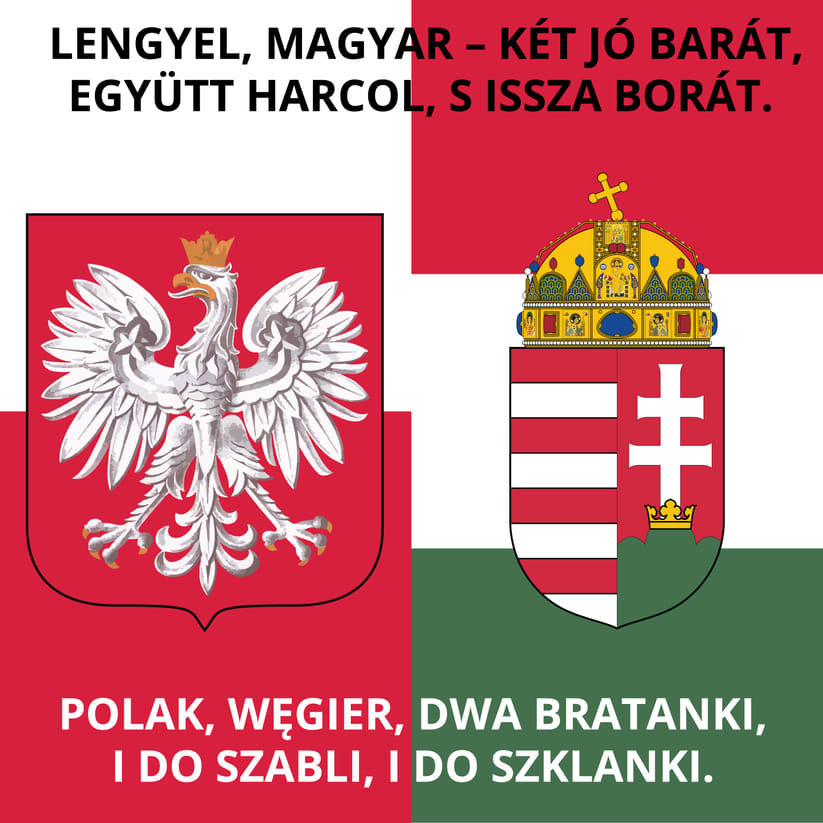Today is the Day of Hungarian-Polish friendship. The friendship between the Hungarian and Polish peoples goes back almost a thousand years to King Ladislaus I of Hungary, and the two nations have been in active contact from the mid-1000s to the present day. Despite the fact that politicians from the two countries sometimes have different opinions on world politics, a Hungarian greeting is still a good recommendation for a Hungarian tourist visiting Poland.
The most significant inter-state relationship of the past centuries, which quickly developed into a friendship in Central Europe, was that between the Kingdom of Hungary and Poland. This friendship, which dates back almost a thousand years, goes back to the time of Ladislaus I of Hungary, whose mother, Richeza of Poland, Queen of Hungary, was a Polish princess of the Piast dynasty. Our knight-king was born in Poland around 1040.
During the reign of Louis the Great in Hungary, Europe’s most important state, the Union of Hungary and Poland was created, a common state, a so-called personal union, that was a worthy counterweight to the mighty Holy Roman Empire in terms of both territory and economic and military power.
During the fights against the Turks, the Christian Polish state helped the warring Kingdom of Hungary in many ways: Polish king John III Sobieski personally led his troops of Kashubians and Polish soldiers during the Turkish siege of Vienna in 1683, to drive back the Ottoman troops at Párkány and thus liberate Esztergom, the center of Hungarian Christianity.

Hungarians and Poles remembering their friendship day with their flags. Photo: Facebook/A háborúk világa, a világ háborúi
After the fall of Rákóczi’s War of Independence in the 17th century, the Kuruc fighters found refuge in Poland, and the leader of the war, Francis II Rákóczi himself, reached Rostov, where he later died, via Sandomierz, Warsaw, and Gdansk, all Polish cities.
Later on, during the 1848-49 Hungarian revolution, Józef Bem, a Polish general and a national hero of Poland and Hungary, and the volunteers of the Polish legion, helped the Hungarians who were groaning under the Habsburg yoke, to regain their freedom. As Hungary’s national poet Sándor Petőfi put it, it was not up to General Bem, called ‘Ostrolenka’s bloody star,’ that the struggle for freedom was finally put down by the Habsburgs with the help of the Russian Tsar.
As we go further along in history, we can see that in the hell of the First World War, Hungarian and Polish soldiers suffered the Russian overwhelming force on the Eastern Front, and the fortress of Przemysl and the Battle of Limanowa remained a painful memory in the lives of many Hungarian and Polish families. Nearly 120,000 soldiers were taken as prisoners of war by the Russians at Przemysl in Galicia, including the distinguished poet Géza Gyóni, whom unfortunately Marxist historians have tried to erase from memory and from literature books.

The popular saying about the traditional kinship, brotherhood, and camaraderie between Poles and Hungarians: “Pole, Hungarian — two good friends, they battle together and drink their wine.” Photo: Facebook/Viktor Hradeczky
After the German and Soviet occupation of Poland in 1939, the Hungarian state was the first to lend a helping hand to the Polish people. In Balatonboglár, with the powerful support of Count Pál Teleki, Europe’s only functioning Polish grammar school was established, giving shelter and bread to tens of thousands of Poles, and even helped thousands of Polish soldiers to reach the Allies through Yugoslavia, where they took part in the defense of England, the Battle of Monte-Cassino, and the European battles against the Germans. In return, the victors pushed Poland into Stalin’s lap.
During the 1956 revolution in Hungary, Polish people wanted to help Hungarians and an aid fever reached the country. Polish students stood guard in front of the Hungarian Institute in Warsaw, hospitals collected blood plasma, and Poles also stockpiled clothes and medicines. A wave of solidarity swept through the country, from the working-class city of Katowice to the intellectuals of Krakow and the ancient episcopal seat of Przemysl.
During the decades of communism, Polish and Hungarian intellectuals still sought each other out, in most cases illegally.
Poets Sándor Csoóri and Grácia Kerényi, literary translator Erzsébet Szenyán, and journalist Attila Szalai met famous Poles such as poet Tadeusz Nowak, writers Tadeusz Konwicki and Wisława Szymborska, and even Anna Walentynowicz, legendary activist of the Solidarity movement, on joint holidays and in camps.
The years following the fall of communism have somewhat eclipsed the friendship between the two peoples, with both societies turning to the West, somewhat neglecting the existing relationship between Warsaw and Budapest.
However, the revival of the Visegrád Cooperation in 1991 by Hungarian Prime Minister József Antall brought the countries of the region back together: economic and cultural relations between the Czech Republic, Poland, Slovakia, and Hungary began to prosper again after the fall of the Iron Curtain.
On the occasion of the day of Hungarian-Polish friendship, Hungarian President Katalin Novák visited the House of Polish-Hungarian Friendship in Balatonboglár, at Lake Balaton. She will also have a telephone conversation with Polish President Andrzej Duda in the afternoon to reaffirm the historic ties between the two nations on this remembrance day.
Hungarian Justice Minister Judit Varga also commemorated the friendship day on her Facebook page. She wrote that despite all the difficulties, Poland and Hungary are two good friends and will remain so.
Secretary of State for International Relations Zoltán Kovács commemorated the day of friendship with the words of Polish politician Stanisław Worcell: “Hungary and Poland are two ever-living oaks that have grown separate trunks, but their roots run far underground, interconnected, and invisibly intertwined. Therefore the existence and vigor of one is a condition of the life and health of the other.”
Via Hirado.hu, Featured Photo: Facebook/Magyar-Lengyel Baráti Társaság Somogy Megyei Szervezete